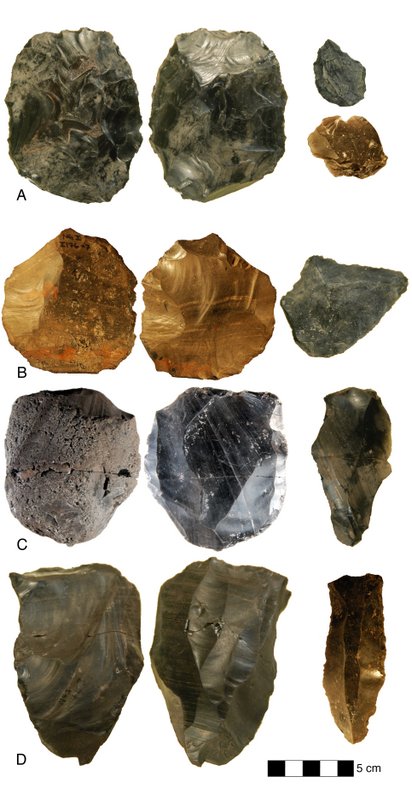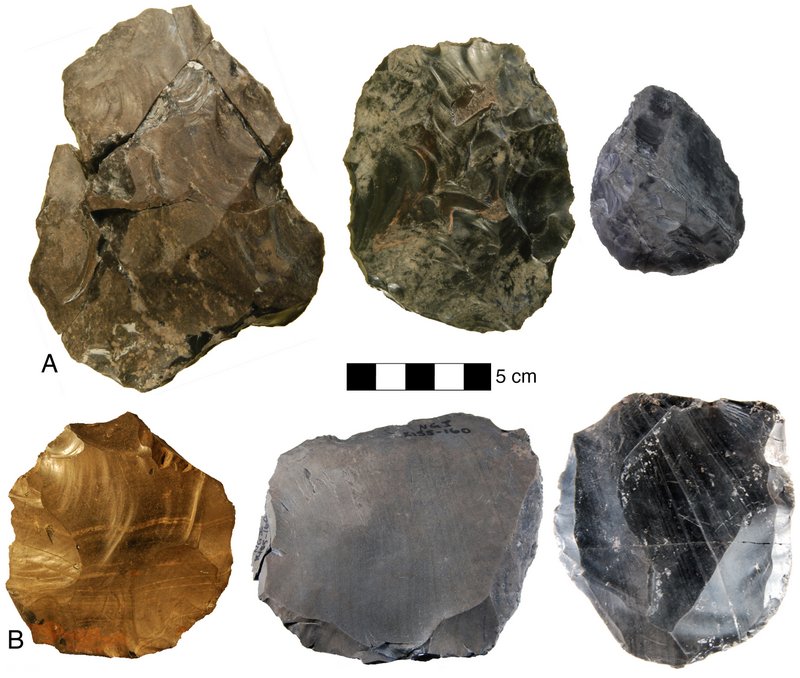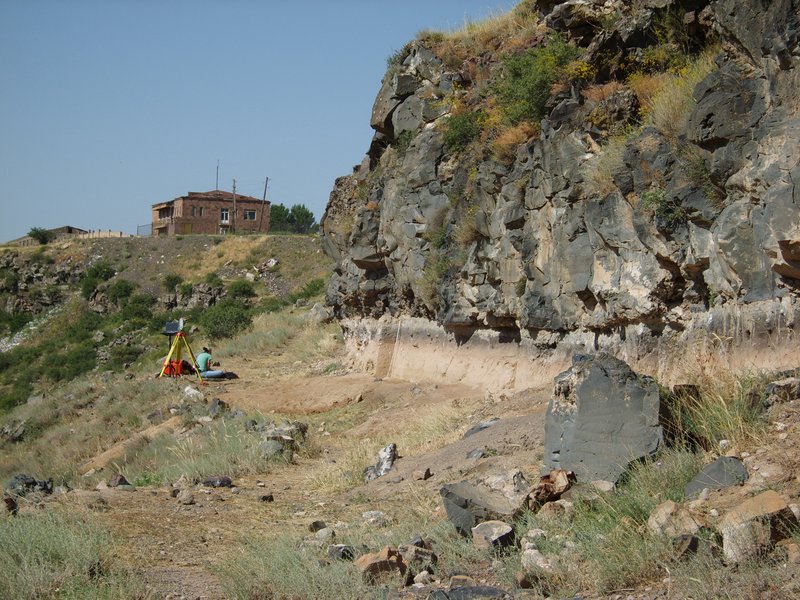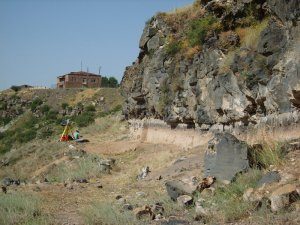
It wasn’t exclusively the arrival of new people from Africa with new technology that changed the stone tool repertoire of early humans in Eurasia a few hundred thousand years ago—it was local populations in different places and times gradually and independently wising up to a better industry on their own.
So suggests Daniel Adler, associate professor of Anthropology at the University of Connecticut, and colleagues based on a recently completed study in which the researchers examined thousands of stone artifacts recovered from Nor Geghi 1, an Armenian Southern Caucasus archaeological site that features preserved lava flows and artifact-bearing sediments dated to between 200,000 and 400,000 years ago. The artifacts, dated at 325,000 – 335,000 years old, were a mix of two distinct stone tool technology traditions—bifacial tools, such as hand axes, which were common among early human populations during the Lower Paleolithic, and Levallois, a stone tool production method typically attributed to the Middle Stone Age in Africa and the Middle Paleolithic in Eurasia. The researchers argue that the coexistence of two technologies at Nor Geghi 1 provides the first clear evidence that local populations developed Levallois technology out of existing biface technology.
“The combination of these different technologies in one place suggests to us that, about 325,000 years ago, people at the site were innovative,” says Adler.
_____________________________________
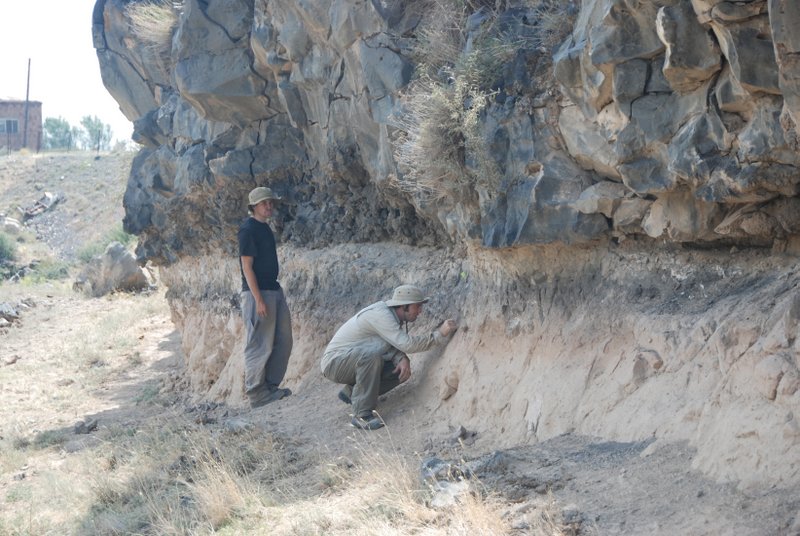 The discovery of Nor Geghi 1 (NG1), July 2008, with Basalt 1 (top) and stratigraphic Units 1–5. N. Researchers Wales and P. Glauberman are pictured. Credit: Daniel S. Adler
The discovery of Nor Geghi 1 (NG1), July 2008, with Basalt 1 (top) and stratigraphic Units 1–5. N. Researchers Wales and P. Glauberman are pictured. Credit: Daniel S. Adler
___________________________________
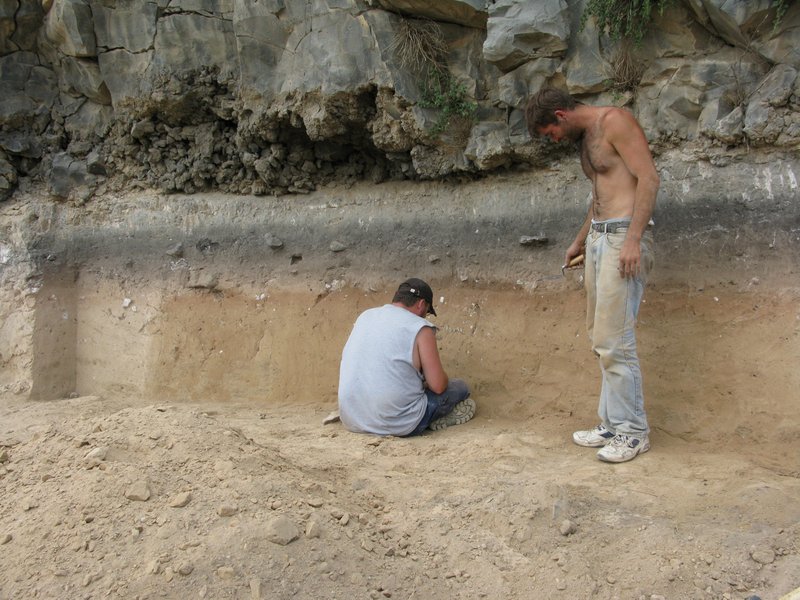 Representative stratigraphic section of Nor Geghi 1 (NG1), with Basalt 1 (top) and Units 1–5, following the 2009 field season. Credit: Daniel S. Adler
Representative stratigraphic section of Nor Geghi 1 (NG1), with Basalt 1 (top) and Units 1–5, following the 2009 field season. Credit: Daniel S. Adler
__________________________________
The paper documenting the research, published in the 26 September 2014 issue of Science, presents the argument that biface and Levallois technology, while distinct, share a common evolutionary line. In biface technology, a stone is shaped through the removal of flakes from two opposite surfaces of the stone to produce a tool such as a hand axe. The detached flakes are discarded as waste products. In Levallois technology, the stone is shaped through the removal of flakes to produce a central convex surface tool, or core. The flakes are produced in predetermined sizes and shapes and used as tools. Archaeologists have suggested that Levallois technology is optimal in terms of raw material. The flakes are relatively small and easy to carry, useful for the highly mobile hunter-gatherers of the time. It has been interpreted as an advancement or innovative improvement on the biface technology.
Based on comparisons of archaeological data from sites in Africa, the Middle East, and Europe, the study authors suggest that this change was gradual and intermittent, and that it occurred independently within different human populations who shared a common technological ancestry. In other words Levallois technology evolved out of pre-existing biface technology in different places at different times.
___________________________________
Technological variability at Nor Geghi 1 (NG1). A) Biface with two biface resharpening/thinning flakes. B–C) Levallois cores with Levallois flakes. D) Blade core with blade. A) The biface is the desired product, with the flakes detached during shaping and resharpening treated as waste. B–D) The flakes and blades are the desired products and were used in an unmodified state or retouched into a variety of tool types. Credit: Daniel S. Adler
_____________________________________
Technological evolution and variability at Nor Geghi 1 (NG1). A) bifaces, B) Levallois cores. Credit: Daniel S. Adler
___________________________________
Their conclusion challenges the view that technological change resulted from population change (the introduction of or replacement of an older population by a new population) during this period. “If I were to take all the artifacts from the site and show them to an archaeologist, they would immediately begin to categorize them into chronologically distinct groups,” Adler says. However, he suggests that the artifacts found at Nor Geghi 1 actually reflect the technological flexibility and variability of a single population, speaking to the antiquity of the human capacity for innovation.
________________________________________
Nor Geghi 1 (NG1) at the close of the 2009 field season. Credit: Daniel S. Adler
______________________________________
This study is the first to present data from Nor Geghi 1, and the research conducted at the site is a collaboration between the University of Connecticut, Yerevan State University, and the Institute of Archaeology and Ethnography, Yerevan. Intellectual contributions to this research were made by and international team of collaborators from Armenia, the United Kingdom, Canada, Spain, Holland, Germany, Ireland, and the United States. Funding for this research was provided by the University of Connecticut (the Norian Armenian Programs Committee, the College of Liberal Arts and Science, the Office of Global Affairs, Study Abroad, and the CLAS Book Committee), the UK Natural Environment Research Council, the L.S.B. Leakey Foundation, the Irish Research Council, and the University of Winchester, UK.
Source: Written with adapted and edited sections included from a University of Connecticut press release, Stone Age site challenges old archaeological assumptions about human technology
________________________________________
Travel and learn with Far Horizons.
Read about the most fascinating discoveries with a premium subscription to Popular Archaeology Magazine. Find out what Popular Archaeology Magazine is all about. AND MORE:
On the go? Get the smartphone version of Popular Archaeology as an app or as an ebook.
Popular Archaeology’s annual Discovery Edition eBook is a selection of the best stories published in Popular Archaeology Magazine in past issues, with an emphasis on some of the most significant, groundbreaking, or fascinating discoveries in the fields of archaeology and paleoanthropology and related fields. At least some of the articles have been updated or revised specifically for the Discovery edition. We can confidently say that there is no other single issue of an archaeology-related magazine, paper print or online, that contains as much major feature article content as this one. The latest issue, volume 2, has just been released. Go to the Discovery edition page for more information.

